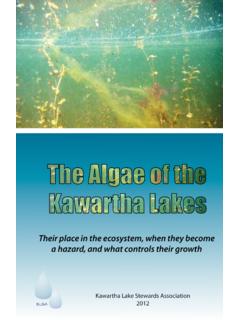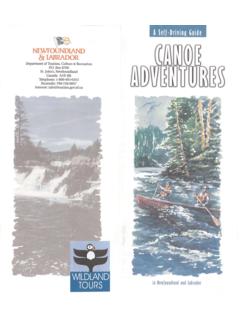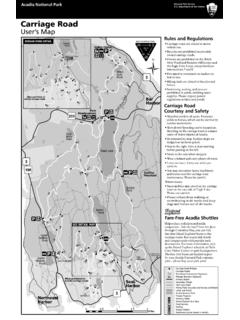Transcription of Fish Community - Lakefield Herald
1 Clear, Ston(e)y and White Lake Plan fish Community The lakes support a cool/warm water fishery including muskellunge, walleye, largemouth and smallmouth bass, yellow perch, pumpkinseed, rockbass, blue gill, bullhead, black crappie and carp. Several of these species, including walleye, have been introduced to Ston(e)y Lake. Muskellunge, however, are naturally found in the lakes, but their population remains low at least partly due to environmental stresses including habitat alteration and the presence of invasive species. For example, zebra mussels increase water clarity, having an adverse effect on zooplankton and small fish communities via predation. Loss of these species eventually affects the food chain. In turn muskie populations are at risk. The migration of northern pike from other reaches of the TSW system is also a potential future stressor. Historic records indicate that our lakes and streams once provided a good habitat for 28 species, including cold water species such as lake herring, lake white fish , lake trout, Atlan- tic salmon and freshwater shrimp.
2 However, changes in land use and resultant impacts to wa- ter quality, water level and temperature changes and doubtless other factors have resulted in a dramatic decline approaching complete loss of these species. Although bass, walleye, muskel- lunge and brook trout were stocked during the 1900s, this practice has been discontinued. Upper Stoney Lake also maintains some cold water habitat for its lake herring and lake whitefish population. An MNR netting program in 2005 confirmed the presence of both spe- cies. fish Habitat, Streams and Rivers fish Habitat The preferred habitats for muskellunge and largemouth bass are the vegetated or mud- bottomed wetland-type areas for breeding, nurseries and feeding. Walleye breed in fast- moving pebbly or rocky shoreline areas and rivers, devoid of dense vegetation. Smallmouth bass are often observed in or near walleye habitats.
3 These fish prefer hard-bottomed areas of clear water, with clean gravel, sand or rocky substrate found in quiet bays, island shoals and undisturbed shorelines. Important wetland and shoreline habitat for muskellunge is shown on Map 3. Sporadic data collected by the Trent-Severn Waterway, Ministry of Natural Resources, and locally funded independent studies were incorporated in our mapping efforts. The darker areas indi- cate historic spawning beds for muskellunge and the adjacent areas indicate protective buffer zones for consideration in any further development or change to the lake. Muskellunge may become lost to our lakes like the lake trout if management efforts fail to protect this spe- cies. Map 4 (on the next page) also shows a fish Sanctuary area, in which fishing is prohib- ited from the opening of the panfish season (end of April) for an extra week after the walleye season opens on the second Saturday in May.
4 This is consistent with other fast water sanctu- aries in the area, and protects walleye as they gather before, during and post-spawning. This type of protection is part of the Ministry of Natural Resources Kawartha-wide initiative to focus on the decline in walleye. 2 Clear, Ston(e)y and White Lake Plan Clear, Ston(e)y and White Lake Plan 3. 4 Clear, Ston(e)y and White Lake Plan Clear, Ston(e)y and White Lake Plan 5. OBSERVED THREATS TO fish AND fish HABITAT. Modification of fisheries habitat: alterations to shoreline and lake bed via filling, dredging, removal of aquatic vegetation, channelizing, docks and boathouses and retaining walls, and the removal of natural habitat such as stumps, logs, and rocks. Most notable is the incremental loss/change in habitat for our valued indicator species - those species which indicate an environmental condition such as a disease outbreak, pollution, species competition or climate change.
5 Indicator species can be among the most sensitive species in a region, acting as an early warning to monitoring biologists. In our region, muskie is the indicator species; and there are documented declines in catch of both muskie and walleye. Over-fishing, poaching or angling out of season of all fish species: particularly walleye and panfish. Impacts of invasive species: increasing clarity of the water by zebra mussels permits deeper light penetration which encourages plant growth and increases water load concentration of Nutrients. Loss of deep-water dissolved oxygen and deep-water fish habitat disrupts the natural food chain and increases competition for forage fish . An acceptable baitfish species education program would help minimize the risk of introducing other invasive species. Excessive nutrient loading and pollution: from fertilizing lawns, grey water dumping or release from holding tanks, and septic systems causing excessive weed growth.
6 Climate change: increasing water temperatures favouring other species and causing weed growth. RECOMMENDATIONS. fish HABITAT. 17. Protect all fish habitat, including all wetlands and natural shoreline areas via government due diligence in permitting and development applications. 18. Encourage replacement of ageing shoreline infrastructure (failing armour stone walls, concrete docks) with natural features instead of upgrading existing structures. 19. Conduct research to confirm wetland fisheries habitat for indicator species. 20. Encourage agencies to inventory the current lake stock and help formulate a plan for sustainability, including monitoring of species at risk. 21. Actively promote best practices for homeowners and fishing enthusiasts to protect fisheries and fisheries habitat. 6 Clear, Ston(e)y and White Lake Plan Streams and Rivers Streams and rivers are a significant feature of the landscape and an integral source of water to the lake.
7 Both systems provide important habitat for fish and wildlife, as well as freshwater from ground sources. OBSERVATIONS STREAMS AND RIVERS. There are a total of 35 streams connected to Ston(e)y and Clear Lakes, including Eel's, Jack's, Perry's and Julia Creeks, and two outflows via the Indian and Otonabee Rivers. Several of these streams are intermittent; that is, a stream which dries up for three months or more of the year. All of the streams oc- cur on privately-owned land. Only three streams have been assessed for thermal regimes (temperature of the water) which defines fish habitats; two feeding Big Duck Pond and one feeding Hull Bay. Inappropriate development and human activity may threaten stream fish habitats and communities through the loss of riparian vegetation, removal of structural habitat (woody debris and rocks), sedimentation, nutrient impacts, channelization, herbicides, pesticides infilling, dredging, damming and changes in flow regime.
8 Big Duck Pond, Stoney Lake RECOMMENDATIONS. STREAMS AND RIVERS. 22. Promote naturalized buffer zones for streams;. 15 metres for warm and 30 metres for cold waters. 23. Expand stream inventories to identify and map important fish habitat. The Disappearing Stream on the Elliott property Bridge to Green Isla





